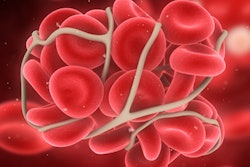A focused ultrasound imaging technique called passive cavitation imaging (PCI) can track the amount of a drug that crosses the blood-brain barrier to reach a specific location in the brain, according to a study funded by the U.S. National Institute of Biomedical Imaging and Bioengineering (NIBIB) and published in Scientific Reports (2019, Vol. 9, article 2840).
The technique monitors the behavior of microbubbles in the ultrasound field without the radiotracers needed for PET/CT imaging, the modality typically used for this type of application, according to lead study author Yaoheng Yang of Washington University in St. Louis. Recording the microbubbles' behavior creates an image that helps researchers track the location and amount of drug during focused ultrasound blood-brain-barrier treatment, the team wrote.
The PCI technique's results matched those of PET/CT images, Yang and colleagues found.
"Our results demonstrated a pixel-by-pixel correlation between the PET and PCI images," said senior author Hong Chen, PhD, in a statement. "With our new technique, we can predict exactly where a drug will go and how much of it will be released when it gets there. It helps us to minimize a drug harming healthy parts of the brain and avoid ineffective treatments when not enough drug reaches the intended target."



















